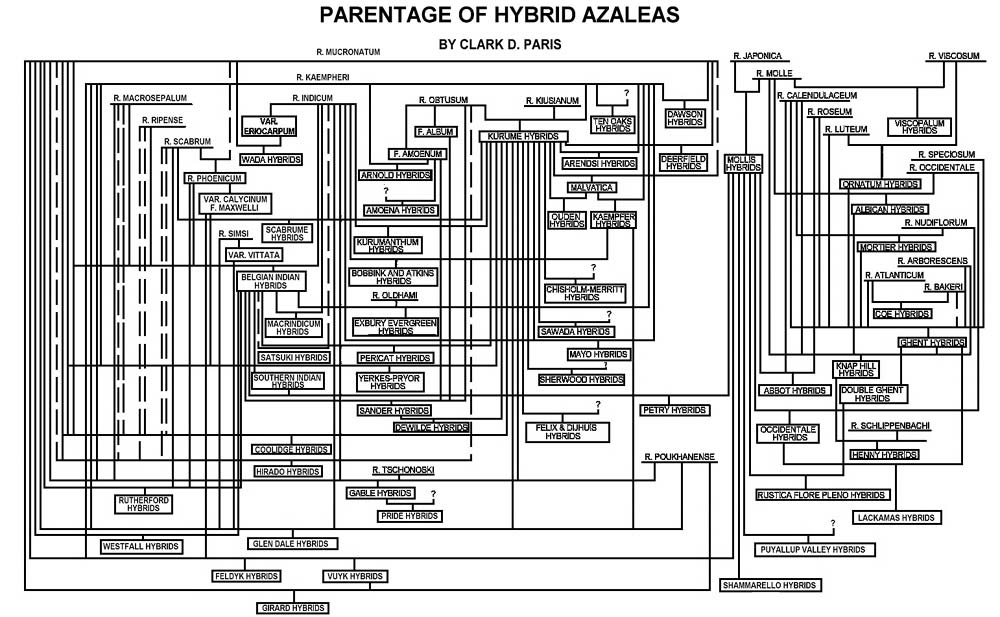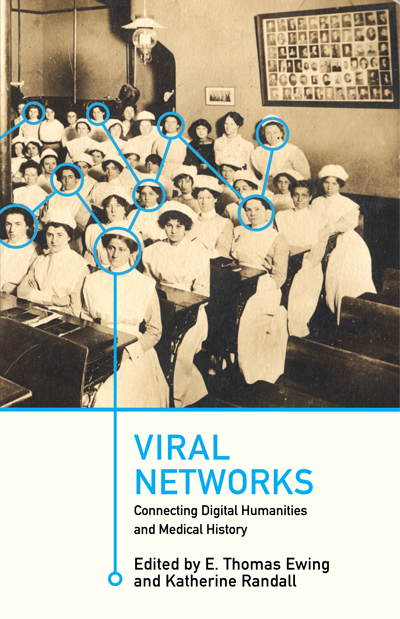QBARS - v14n1 The Parentage of Hybrid Azaleas
The Parentage of Hybrid Azaleas
by Clark D. Paris
Department of Horticulture
Michigan State University*
*The author wishes to thank Prof. C. E. Lewis for his assistance in collecting this data.
In 1753 when the immortal Linnaeus described the genera Azalea and Rhododendron , he initiated a controversy which has continued for almost two centuries. Most taxonomists agree that any line of demarcation between these two genera is entirely arbitrary; yet in 1942, Lemmon and McKay described a new species as Azalea furbishii. Shakespeare said that "a rose by any other name would smell as sweet". In this paper all species of "azaleas" are considered of the genus Rhododendron .
Regardless of the validity of the genus Azalea , this name has been retained for a group of plants that are very popular wherever they can be grown successfully. The wild species have been cultivated since the seventeenth century. When the pioneer hybridizers began crossing species of plants, the azaleas were among the first with which they worked. As more rhododendrons were introduced, these were crossed with the existing varieties. Each breeder developed his own breeding objectives and worked towards them until definite races of hybrids became known. Usually these races were named for the originator or the place where he worked. A complete list of azalea hybrid groups, as well as certain pertinent data about each, is given in Table I. The introduction dates of the hybrids were obtained directly from the originators, or their descendents. A study of the parentage of hybrid azaleas has revealed that, as far as is known, only twenty-seven species have been used. These, with the native habitat, color, and year of introduction, are given in Table II. The nomenclature is that given by Lee (4). Rehder (6) relegates some of these to a varietal status. No attempt is being made to give the pros and cons of this debate.
The main purpose of this paper is to present a chart to show the parentage of the introduced hybrid azaleas. The horizontal line above the name of each hybrid connects with a vertical line from each species or hybrid that was used in the production of that particular group. Any one variety does not necessarily contain blood from all parents. A broken line is used if the parent is in doubt. The Southern Indian hybrids and double Ghent hybrids are selections from Belgian Indian hybrids and Ghent hybrids, respectively. The Shammarello hybrids are inbred selections of Mollis hybrids.
This chart is just as accurate as the sources of information used. Like all progeny or pedigree records the originator's information is accepted as prima-facie evidence. Although it is probably at a bare minimum the possibility of deliberate misinformation cannot be wholly discounted. Several other sources of error are possible. One of the more plausible is the misidentification of parent material. Most people do not systematically check the material with which they are working, and then too, the same name has sometimes been applied to different plants. The old practice of giving Latin names to hybrids adds to the confusion. Sometimes the originator did not keep adequate records and depended on memory. Another early practice was the mixing of pollen and then when something of value was obtained an attempt was made to postulate the pollen parent by studying the hybrid. A less obvious pitfall is apogamy. When the seed is produced without actual fertilization occurring. The seeds so produced actually contain only maternal tissue.
|
Table I
Introduced Hybrid Azalea Groups |
||
| Hybrid Group | Originator | Introduced |
| Abbott | Frank L. Abbott, Bellows Falls, Vermont | About 1943 |
| Albican | Anthony Waterer, Woking, Surrey, England | About 1870 |
| Allan* | Walter Allan, Summerville, N. Carolina | 1950 |
| Amoena | Various English growers | 1860 |
| Arends | George Arends, Ronsdorf, Germany | 1926 |
| Arnold | Jackson T. Dawson, Jamaica Plain, Mass. | About 1910 |
| Belgian Indian | Growers in England and Belgium | Early 1800's |
| Blaauw* | J. Blaauw and Co., Boskoop, Holland | |
|
Bobbink and Atkins
Macrantha |
Bobbink and Atkins, East Rutherford, N.J. | About 1942 |
| Chisholm-Merritt | Julian Chisholm, Garrett Park, Maryland | About 1947 |
| Coe | Frederick W. Coe, Bethesda, Maryland | |
| Coolidge | Coolidge Rare Plant Gardens, Pasadena, Calif. | 1930's |
| Dawson | Henry S. Dawson, Eastern Nurseries. Holleston, Mass. | After 1923 |
| De Wilde | Roland de Wilde, Rhodo-Lake Nurseries, Bridgeton, N. J. | 1947 |
| Deerfield | Deerfield Nursery, Deerfield Street P.O., N.J. | 1950 |
| Dosser* | Lillie Dosscr, Centralia, Washington | 1955 |
| Exbury Evergreen | Lionel de Rothschild, Exbury, Southampton, England | About 1955 |
| Feldyk | Felix and Dijhuis, Boskoop, Holland | 1930 |
| Felix and Dijhuis | Felix and Dijhuis, Boskoop, Holland | 1946 |
| Ferndown* | D. Stewart and Son, Ltd., Ferndown, Dorset, England | 1946 |
| Gable | Joseph B. Gable, Stewartstown, Pa. | 1927 |
| Ghent | Growers around Ghent, Belgium | Early 1830's |
| Girard | Peter E. Girard, Girard Bros. Nursery, Geneva, Ohio | 1954 |
| Glenn Dale | United States Department of Agriculture | 1941 |
| Hage* | W. C. Hage and Co., Boskoop, Holland | 1938 |
| Henny | Rudolph Henny, Brooks, Oregon | Not Introduced |
| Hirado | Unknown. Island of Hirado, Japan | 1952 |
|
Kaempferi
(Malvatica) |
P. M. Koster, Boskoop, Holland | 1920's |
| Kingsville* | Henry J. Hohman, Kingsville Nurseries, Kingsville, Maryland | |
| Knaphill | Anthony Waterer, Woking, Surrey, England | About 1870 |
| Knaphill Strain | Knap Hill Nursery, Woking, Surrey, England | 1860's |
| Slocock Strain | Goldsworth Old Nursery, Ltd., Woking | 1947 |
| Ilam Strain | Edgar Stead, Ilam Estate, Christchurch, New Zealand | |
| Exbury Strain | Lionel de Rothschild, Exbury, Southampton, England | Early 1930's |
| Koppeschaar* | W. F. Koppeschaar, Boskoop, Holland | |
| Kurumanthum | K. Wada, Kakoneya Nurseries, Numazushi, Japan | Before 1941 |
| Kurume | Mitozo Sakamoto, Kurume, Japan | Early 1800's |
| Lackamas | Ben Lancaster, Lackamas Gardens, Camas, Washington | 1951 |
| Macrindicum | K. Wada, Kakoneya Nurseries, Numazushi, Japan | Before 1941 |
| Mayo | R. P. Mayo Nurseries, Augusta Georgia | About 1940 |
| Mollis | Louis Van Houtte, Ghent, Belgium | Before 1873 |
| Mortier | P. Mortier, Ghent, Belgium | About 1830 |
| Occidentale | Growers in England and Holland | About 1895 |
| Ornatum | J. R. Gowen, Highclere, England | About 1831 |
| Ouden | H. den Ouden and Son, Boskoop, Holland | 1938 |
| Pericat | Alphone Pericat, Collingdale, Pa. | 1931 |
| Petry | Mrs. Frank Petry, Prichard, Alabama | After 1948 |
| Pride | Orlando S. Pride, Butler, Pennsylvania | After 1934 |
| Puyallup Valley | Leonard F. Frisbie, Puyallup, Washington | About 1954 |
|
Rustica Fiore Pleno
(Mixtum) |
Charles Vuylsteke, Belgium | About 1900 |
| Rutherford | Bobbink & Atkins. East Rutherford, N.J. | 1920's |
| Sander | Charles Sander, Brookline, Mass. | About 1885 |
| Satsuki | Unknown, Japan | Before 1700 |
| Sawada | K. Sawada, Overlook Nurseries, Mobile, Ala. | About 1950 |
| Scabrume | K. Wada, Kakoneya Nurseries, Numazushi, Japan | Before 1941 |
| Shammarello | A. Shammarello, South Euclid, Ohio | Not Introduced |
| Sherwood | Sherwood Nursery Co., Corbett, Oregon | 1935 |
| Southern Indian | Magnolia Gardens, Charleston, S. Carolina | 1840 |
| Ten Oaks | Ten Oaks Nursery, Clarksville, Maryland | 1948 |
| Viscosepalum | Growers in England | Early 1800's |
| Vuyk | Vuyk van Nes Nursery, Boskoop, Holland | 1926 |
| Wadai | K. Wada, Kakoneya Nurseries, Numazushi, Japan | Before 1941 |
| Westfall | Quincy R. Westfall, California | About 1950 |
| Yerkes-Pryor | Guy E. Yerkes, U. S. D. A., Beltsville. Maryland | |
| *Parentage unknown. | ||
|
Table II
Rhododendron Species Used In The Production Of Hybrid Azaleas |
|||
| Species | Native Habitat | Introduced | Color |
| R. arborescens (Pursh) Torr. | Eastern U. S. | Before 1814 | White or pinkish |
| R. atlanticum (Ashe) Rehd. | Eastern U. S. | About 1916 | White or pinkish |
| R. bakeri Lemm. & McKay | Southeastern U. S. | 1938 | Deep yellow to orange scarlet |
| R. calendulaceum (Michx.) Torr. | Eastern U. S. | Before 1800 | Yellow to scarlet |
| R. canescens (Michx.) Sweet | Southern U. S. | 1750? | Pink and white |
| R. indicum (L.) Sweet | Japan | Before 1680 | Bright red to scarlet |
| R. japonicum (Gray) Suringar | Japan | 1861 | Orange-red or salmon-red to brick-red |
| R. kaempferi Planch. | Japan | 1892 | Red or orange-red to pink |
| R. kiusianum Mak. | Japan | 1955 | Purple |
| R. luteum Sweet | Asia Minor, Eastern Europe | 1792 | Yellow |
| R. macropetalum Maxim. | Japan | 1863 | Rose-lilac to rose-purple |
| R. molle (B1.) G. Don | China | 1823 | Golden-yellow |
| R. mucronatum G. Don | Japan | 1819 | White |
| R. nudiflorum (L.) Torr. | Eastern U. S. | About 1930 | Light pink or white |
| R. obtusum (Lindl.) Planch. | Japan | About 1844 | Orange-red to bright red |
| R. occidentale Gray | Western U. S. | 1850 | White or pinkish |
| R. oldhamii Maxim. | Formosa | 1878 | Red |
| R. phoenicum G. Don | Unknown, may be hybrid | 1824 | Rose-purple to magenta |
| R. poukhanense Levl. | Korea | 1905 | Pale lilac-purple |
| R. ripense Mak. | Japan | ? | Rose-purple |
| R. roseum (Loisel.) Rehd. | Eastern U. S. | About 1790 | Bright pink |
| R. scabrum G. Don | Japan | Before 1911 | Rose-red to scarlet |
| R. schlippenbachii Maxim. | Eastern Asia | 1893 | Pale to rosy pink |
| R. simsii Planch. | China, Formosa | 1808 | Rose-red to bright or dark red |
| R. speciosum Sweet | Georgia, U.S.A. | 1830 | Scarlet-red |
| R. tschonoskii Maxim. | Japan, Korea | 1878 | White |
| R. viscosum (L.) Torr. | Eastern U. S. | Before 1731 | White or suffused pink |

|
| Fig. 6 |
BIBLIOGRAPHY
1. Arends, Georg, Mein Leben als Gartner and Zuchter, Stuttgart: Eugen Ulmer, 1951.
2. Bowers, Clement Gray, Rhododendrons and Azaleas, New York: Macmillan, 1936.
3. Hume, H. Harold, Azaleas, New York: Macmillan, 1956.
4. Lee, Frederic P., The Azalea Book, Princeton: D. Van Nostrand, 1958.
5. Pinckney, G. H., Hardy Hybrid Azaleas-Their Evolution and Range, Royal Horticultural Society, The Rhododendron and Camellia Year Book, 9:31-36, 1955.
6. Rehder, Alfred, Manual of Cultivated Trees and Shrubs, Second edition, New York: Macmillan, 1940.
7. Wilson, E. H. and Rehder, Alfred, A Monograph of Azaleas, Cambridge, Harvard Univ. Press, 1921.
8. Wyman, Donald, Shrubs and Vines for American Gardens, New York: Macmillan, 1949.
